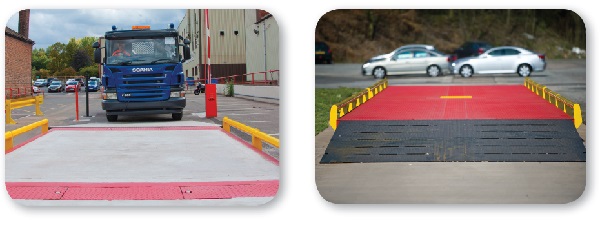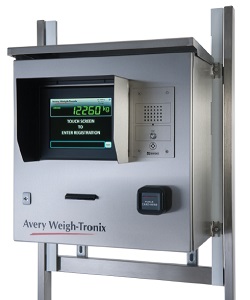Weighbridges: A Buyer’s Guide
A weighbridge is a major investment. While it is vital to get a site survey and specify each weighbridge according to environment and use, there are common features across all weighbridges that it pays to understand.
The Weighbridge Buyer’s Guide, from Avery Weigh-Tronix, covers seven key areas to consider when speaking to your chosen supplier(s).
Pit or surface mounted weighbridges?
When it comes to selecting a weighbridge, one of the first big decisions is whether to go for a pit or surface mounted bridge. In many cases, the answer will be dictated not only by usage and budget, but by the site conditions.

Surface mounted weighbridges
As the name suggests, this type of weighbridge simply sits on top of the road surface. This minimises the amount of foundation work required. This design is often selected when the bridge may need to be moved, or in temporary installations. Because the weighbridge sits above the road surface on/off ramps are added to each end of the scale. This enables easy access.
Before purchasing, check the overall height of the weighbridge. Higher decks need longer ramps. This increases the overall footprint of the weighbridge as well as the turning circle for vehicles approaching the bridge. For safety, extreme-duty guide rails are bolted in place. This provides a strong and effective way of keeping vehicles centrally positioned on the bridge.
Pit mounted weighbridges
These weighbridges are installed in a pit, keeping them flush to the road surface. Because these bridges don’t require ramps, they take up less surface area. This makes them ideal for smaller areas or sites where vehicle flow might change direction. Initial civil and foundation work can make pit installation a more expensive option. However, many weighbridges can be mounted in existing pits. This reduces the need for costly foundation changes when replacing existing bridges.
Weighbridge decks
Concrete or steel? Weighbridges are available with both concrete and steel deck surfaces, both of which offer their own benefits.

Environmental considerations
A shot blasted and well painted steel deck can provide a very hard-wearing finish. This will work to keep the elements at bay. However, in extremely wet and potentially corrosive environments, a concrete deck may provide a more durable solution with greater traction.
Short vs long term benefits:
Steel decks can prove faster, easier and in some cases more cost effective to install. They also benefit from being easier to relocate, if required. While concrete requires additional time to pour, level and dry out before use, a concrete deck can offer a longer life in tough conditions. Speak to your supplier about the conditions of use on your site. Consider its impact on the long-term cost of ownership before making a decision.
Design and construction
Look carefully at the way that the bridge deck is constructed. Concrete decks should be reinforced by a high strength steel construction. Concrete is extremely strong in compression but is known to be weaker in tension. By reinforcing the concrete with steel, the deck offers excellent strength in both compression and tension. Equally, if purchasing a steel deck, ensure that you check that the deck is designed and constructed to offer maximum strength. Also check for the quality of the steel and finishing processes used.
Ramps
In the case of surface mounted weighbridges, similar consideration should be applied when selecting steel or concrete approach ramps. Remember that ramps take the brute force of being hit by a vehicle as it mounts the ramp. Concrete can offer longevity, while steel is ideal if the weighbridge is likely to be moved.
Types of load cell
In basic terms, the load cell is the part of any scale that measures the weight or forced being applied. The cells convert the force of the load into an electrical signal. This is then read and displayed by a weight indicator. Load cells come in a range of different sizes, shapes and capacities, with weighbridges frequently using either analogue or digital cells. Generally speaking, both analogue and digital cells use the same strain gauge technology. However, each offer different benefits depending on the environment.
Analogue cells
Analogue load cells are the most common solution. Over time they have evolved to deliver a solution that provides a different set of benefits to a digital cell. The Weigh Bar, for example, features unique self-restoring characteristics without the need for end stops. This means that the cell is less susceptible to the negative effects of shock loading, movement, torque and twist that can occur due to natural movement of the weighbridge as a vehicle enters the platform.
While digital cells are generally available with a higher IP rating, the design of the bridge is an equally important factor when selecting the right cell for your application. Using the same example of the Weigh Bar, the shape of the cell allows it to sit higher in the bridge than many canister load cells, which means that it is kept out of the way of the water and debris that can collect under a weighbridge over time. The location of the cell within the bridge means that the hermetic multi layer sealing process is required to protect the cell from harsh environments, but that an IP69K rating is less important.
Digital cells
Digital canister load cells are a popular choice in weighbridges. Unlike conventional analogue load cells, which rely on external wiring, junction boxes and A to D circuitry, digital cells offer additional protection from the unwanted electrical interference that can affect analogue load cells.
Digital load cells offer high accuracy weighing, with some designs offering equal precision when weighing at an angle. They can be pre-linearised, which allows fast and simple installation and calibration, as well as offering built in diagnostic tools. Generally speaking, a digital cell offers increased data access and the information can be transferred more effectively over longer distances – e.g. if a weighbridge is situated a long way from the weight indicator. However, the electronics that offer these benefits can make the cells more complicated to repair and can restrict your choice of repairer, making it important to check that your service provider is able to deal with a cell before taking the plunge.
Many weighbridges that use canister cells position the cell low in the weighbridge, close to the ground. Look for stainless-steel digital cells with a verified IP69K rating which offers protection against the dirt and water that can build up under the weighbridge.
Bear in mind that digital load cells can be more costly than an analogue alternative. Both provide an accurate and dependable solution, but their suitability varies depending on frequency of use and environmental pressures.
Data requirements and access
Your weighbridge has the potential to provide a wealth of information. This can help you to control wastage, monitor costs and improve efficiencies. Carefully consider what you need from your weighbridge – whether data transfer for invoicing and purchasing, added security and fraud protection, reporting for legislative purposes or sharing data across multiple sites.
It is vital that your software supplier understands the weighing industry and has a proven ability to develop software that seamlessly integrates with your business systems and requirements. Selecting the right peripherals – from software integrated with your back office systems to intelligent weight indicators that can analyse and store data – can greatly increase the value of your weighbridge system.
Weighbridges for ATEX environments
Many sites, such as those handling hazardous waste, may need to consider investing in ATEX compliant equipment. Dust, gases and fumes can get trapped in the area underneath the weighbridge, causing a potentially explosive atmosphere. Remember that installing ATEX compliant equipment is just the beginning as far as explosion prevention is concerned, it is vital to ensure that the service technicians used for ongoing maintenance are suitably qualified, certified and fully compliant with the changing ATEX legislation.
Traffic management and weighbridge automation

Unattended weighbridge systems can automate processing of vehicles without the need for a dedicated operator, reducing operating costs and extending the hours of availability. Adding entry and exit barriers, video surveillance, traffic lights and automatic number plate recognition (ANPR) can manage traffic flow as well as improving security and combating weighbridge theft and fraud by providing important data about who and what is entering and leaving the site. Driver operated systems offer an added safety benefit, allowing drivers to complete weighing transactions 24 hours a day, seven days a week, without having to leave their vehicles. Look for systems that are simple and intuitive to use, have multilingual capability, large graphical characters and a clear display.
Maintenance, repair and calibration
A weighbridge is a major investment. It is wise to also invest in a service and maintenance contract that will minimise downtime, maximise uptime and ensure that your weighbridge keeps operating accurately and efficiently.
Not all suppliers have the expertise and experience to maintain or repair all types and makes of weighbridge. Thoroughly check the credentials of your service provider, including whether they have extensive coverage in your area, the number of qualified technicians and their qualifications and training. When it comes to weighbridges, be sure to look for a supplier that has a dedicated fleet of weighbridge test units to reduce your waiting time if your bridge needs to be re-verified.
Seek expert advice
When investing in such a critical piece of kit, make sure you seek advice from the experts. Most suppliers will be more than happy to offer a site visit to help establish the very best weighing solution for your environment.



 United States
United States  United Kingdom
United Kingdom  Canada
Canada  Canada (fr)
Canada (fr)  Malaysia
Malaysia  Ireland
Ireland